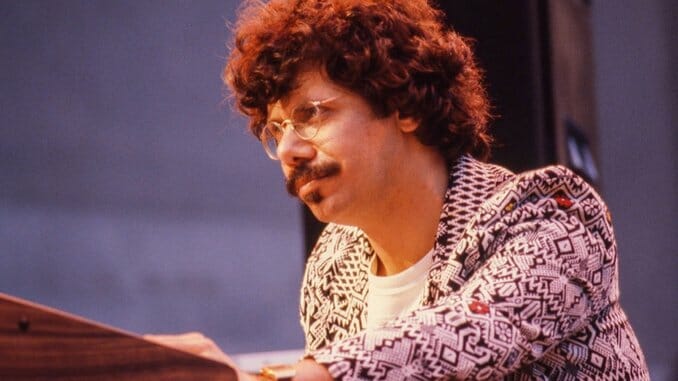The Adventurous Life and Career of Chick Corea (1941-2021)
Photo by Ed Perlstein/Getty
People always say they admire artists who take a lot of risks. Those same observers are often unhappy when those artists stumble. But an artistic risk isn’t a genuine gamble unless there’s a real chance of falling flat on your face.
Chick Corea, who died Tuesday of cancer at age 79, was a fearless musical gambler who had his fair share of stumbles. It was those failed artistic wagers, though, that made his greatest triumphs possible. In this, he took his cue from his most crucial mentor, Miles Davis, who won a lot of musical bets but lost a few too.
In 1966, when jazz’s market share was shrinking and rock was growing not only in album sales but also in artistic ambition, Davis’s former saxophonist Cannonball Adderley had a hit with the song “Mercy, Mercy, Mercy,” written and played on an electric piano by Joe Zawinul. Here was a way, Davis decided, was a way to bring a new audience to jazz: integrate electric instruments and R&B rhythms.
On his 1968 album, Filles de Kilimanjaro, Davis asked his longtime pianist Herbie Hancock, Zawinul and Corea to all experiment with electric keyboards, while Ron Carter tried the electric bass. The results were encouraging enough that for his next album, In a Silent Way, Davis brought back the three pianists and added electric guitarist John McLaughlin, young British bassist Dave Holland and rock-influenced drummer Tony Williams. When Davis took the show on the road, it was with a new quintet featuring Corea, Holland, drummer Jack DeJohnette and saxophonist Wayne Shorter.
It’s easy to understand why Davis settled on Corea as his new keyboardist. The latter had already established his reputation as a skillful, inventive acoustic pianist playing Latin-tinged jazz with Stan Getz, Herbie Mann and Mongo Santamaria. Corea’s father had been a successful trumpeter and bandleader in Boston, so the son (named Armando after his father and nicknamed Chick by his aunt) understood Latin-jazz’s connection between melody, rhythm and improvisation from an early age. He started on the piano at age four.
That gave him the dance pulse and flexibility that Davis was looking for. Their partnership climaxed in the jazz-rock big-band project, Bitches Brew, an album that hit the top-40 pop charts and went platinum. It proved the economic and artistic potential of the jazz-rock fusion movement and included most of that movement’s future leaders: Corea and Lenny White (Return to Forever), Zawinul and Shorter (Weather Report), McLaughlin and Billy Cobham (Mahavishnu Orchestra), and Davis himself.
But when Corea left Davis in 1970, he didn’t dive straight into more fusion. Instead the restless, gambling artist formed an avant-garde quartet with Holland, Anthony Braxton and Barry Altschul to make some of the finest and lowest-selling music of Corea’s career. He recorded an exquisite, unaccompanied duo album with vibraphonist Gary Burton, the first of many collaborations between the two. He also made a Brazilian-jazz album with Flora Purim and Airto Moreira and called the group Return to Forever.
That album, 1973’s Light as a Feather, was a mixed bag, marred by Purim’s pitch problems (Corea never had much luck working with vocalists) and Corea’s overly decorous playing. But the keyboardist liked the name Return to Forever, and he revamped the group as a loud, plugged-in fusion band that finally settled on a line-up of Corea, White, Stanley Clarke and Al Di Meola. Clarke and Di Meola weren’t acoustic jazz players adapting to a new, amplified world; their primary instruments had long been electric bass and electric guitar; thus they had a comfortable familiarity with the buzzing tone and propulsive thrust of the music.
RTF was symptomatic of the ’70s fusion movement it helped lead. On this line-up’s first album, 1974’s Where Have I Known You Before, the themes are strong and the shifts between the hard-hitting ensemble passages and tangential solos made sense. As audiences clamored for weirder sounds and a more aggressive attack, though, the band began to emphasize technology and volume over invention with diminishing results. But Corea was unfazed; he learned as much from his failures as his triumphs and kept moving forward.
He had a choice: he could keep milking the RTF cow or he could use his new-won name recognition to pursue a variety of projects. He wisely chose the latter. That included missteps such as the two 1978 albums, The Mad Hatter and Secret Agent, featuring too many synthesizers and too many vocals by Corea’s wife Gayle Moran. On the other hand, the pianist did delightful unaccompanied acoustic-duet sessions with Herbie Hancock and Gary Burton and formed a fine, semi-acoustic quartet with saxophonist Joe Farrell, drummer Steve Gadd and bassist Eddie Gomez.
Also in the late ’70s, he joined the controversial religious cult Scientology and often thanked the church on his album covers. He never proselytized from the stage or the studio, however, and the extraterrestrial theology never seemed to interfere with his music. The one exception is the 2004 album To the Stars, an instrumental soundtrack based on Scientology founder L. Ron Hubbard’s writings, which are reprinted in the CD booklet. There are some lovely moments but also many moments of overplaying.